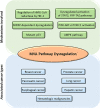The Mevalonate Pathway, a Metabolic Target in Cancer Therapy
- PMID: 33718197
- PMCID: PMC7947625
- DOI: 10.3389/fonc.2021.626971
The Mevalonate Pathway, a Metabolic Target in Cancer Therapy
Abstract
A hallmark of cancer cells includes a metabolic reprograming that provides energy, the essential building blocks, and signaling required to maintain survival, rapid growth, metastasis, and drug resistance of many cancers. The influence of tumor microenviroment on cancer cells also results an essential driving force for cancer progression and drug resistance. Lipid-related enzymes, lipid-derived metabolites and/or signaling pathways linked to critical regulators of lipid metabolism can influence gene expression and chromatin remodeling, cellular differentiation, stress response pathways, or tumor microenviroment, and, collectively, drive tumor development. Reprograming of lipid metabolism includes a deregulated activity of mevalonate (MVA)/cholesterol biosynthetic pathway in specific cancer cells which, in comparison with normal cell counterparts, are dependent of the continuous availability of MVA/cholesterol-derived metabolites (i.e., sterols and non-sterol intermediates) for tumor development. Accordingly, there are increasing amount of data, from preclinical and epidemiological studies, that support an inverse association between the use of statins, potent inhibitors of MVA biosynthetic pathway, and mortality rate in specific cancers (e.g., colon, prostate, liver, breast, hematological malignances). In contrast, despite the tolerance and therapeutic efficacy shown by statins in cardiovascular disease, cancer treatment demands the use of relatively high doses of single statins for a prolonged period, thereby limiting this therapeutic strategy due to adverse effects. Clinically relevant, synergistic effects of tolerable doses of statins with conventional chemotherapy might enhance efficacy with lower doses of each drug and, probably, reduce adverse effects and resistance. In spite of that, clinical trials to identify combinatory therapies that improve therapeutic window are still a challenge. In the present review, we revisit molecular evidences showing that deregulated activity of MVA biosynthetic pathway has an essential role in oncogenesis and drug resistance, and the potential use of MVA pathway inhibitors to improve therapeutic window in cancer.
Keywords: cancer; cholesterol; isoprenoids; mevalonate; oxysterols; statins; sterol regulatory element binding protein.
Copyright © 2021 Guerra, Recio, Aranda-Tavío, Guerra-Rodríguez, García-Castellano and Fernández-Pérez.
Conflict of interest statement
The authors declare that the research was conducted in the absence of any commercial or financial relationships that could be construed as a potential conflict of interest.
Figures




Similar articles
-
The Potential of Isoprenoids in Adjuvant Cancer Therapy to Reduce Adverse Effects of Statins.Front Pharmacol. 2019 Jan 4;9:1515. doi: 10.3389/fphar.2018.01515. eCollection 2018. Front Pharmacol. 2019. PMID: 30662405 Free PMC article. Review.
-
Interconnection of Estrogen/Testosterone Metabolism and Mevalonate Pathway in Breast and Prostate Cancers.Curr Mol Pharmacol. 2017;10(2):86-114. doi: 10.2174/1874467209666160112125631. Curr Mol Pharmacol. 2017. PMID: 26758947 Review.
-
Targeting the Mevalonate Pathway to Overcome Acquired Anti-HER2 Treatment Resistance in Breast Cancer.Mol Cancer Res. 2019 Nov;17(11):2318-2330. doi: 10.1158/1541-7786.MCR-19-0756. Epub 2019 Aug 16. Mol Cancer Res. 2019. PMID: 31420371 Free PMC article.
-
Mevalonate Pathway and Human Cancers.Curr Mol Pharmacol. 2017;10(2):77-85. doi: 10.2174/1874467209666160112123205. Curr Mol Pharmacol. 2017. PMID: 26758953 Review.
-
Could drugs inhibiting the mevalonate pathway also target cancer stem cells?Drug Resist Updat. 2016 Mar;25:13-25. doi: 10.1016/j.drup.2016.02.001. Epub 2016 Feb 20. Drug Resist Updat. 2016. PMID: 27155373 Review.
Cited by
-
Proline oxidase silencing inhibits p53-dependent apoptosis in MCF-7 breast cancer cells.Amino Acids. 2021 Dec;53(12):1943-1956. doi: 10.1007/s00726-021-03013-8. Epub 2021 Jun 4. Amino Acids. 2021. PMID: 34085157 Free PMC article.
-
Lipid metabolic vulnerabilities of multiple myeloma.Clin Exp Med. 2023 Nov;23(7):3373-3390. doi: 10.1007/s10238-023-01174-2. Epub 2023 Aug 28. Clin Exp Med. 2023. PMID: 37639069 Free PMC article. Review.
-
γδ T cells: Major advances in basic and clinical research in tumor immunotherapy.Chin Med J (Engl). 2024 Jan 5;137(1):21-33. doi: 10.1097/CM9.0000000000002781. Epub 2023 Aug 18. Chin Med J (Engl). 2024. PMID: 37592858 Free PMC article. Review.
-
Translational Results of Zo-NAnTax: A Phase II Trial of Neoadjuvant Zoledronic Acid in HER2-Positive Breast Cancer.Int J Mol Sci. 2022 Dec 8;23(24):15515. doi: 10.3390/ijms232415515. Int J Mol Sci. 2022. PMID: 36555156 Free PMC article. Clinical Trial.
-
Targeting of Mevalonate-Isoprenoid Pathway in Acute Myeloid Leukemia Cells by Bisphosphonate Drugs.Biomedicines. 2022 May 16;10(5):1146. doi: 10.3390/biomedicines10051146. Biomedicines. 2022. PMID: 35625883 Free PMC article. Review.
References
Publication types
LinkOut - more resources
Full Text Sources
Other Literature Sources

